Certain individuals who apply for an extension of their previously-approved Employment Authorization Document (EAD) from the United States Citizenship and Immigration Services (USCIS) are eligible for an automatic extension of their employment authorization after the expiration of their current EAD. Previously, that automatic extension period was limited to 180 days after the expiration date listed on the EAD. However, over the past few years, USCIS’s processing time for EAD applications has increased considerably. In many instances, USCIS has failed to adjudicate EAD extension applications before that 180-day automatic extension period lapsed, causing people to lose their ability to work in the United States.
To address this issue, effective May 4, 2022, USCIS has increased that automatic EAD extension period from 180 days to 540 days. Now, if an applicant meets the requirements described below, her employment authorization will continue for 540 days after the expiration of their EAD card, or until the EAD extension application is adjudicated, whichever is sooner.
This increase is temporary, and will expire on October 26, 2023. This increase is applicable to EAD extension applications filed before May 4, 2022 (whether the previous 180-day automatic extension period has already expired or not) and EAD extension applications filed between May 4, 2022 and October 26, 2023, inclusive. Any EAD extension application filed after October 26, 2023 would only have an automatic extension period of 180s days, unless this increase is extended by USCIS.
To be eligible for this 540-day automatic EAD extension, you must meet the following three requirements:
- A Form I-765, Application for Employment Authorization for Renewal of employment authorization is properly and timely filed with USCIS before your current EAD expires;
- You are requesting renewal of employment authorization under the same eligibility category as the eligibility category of your current EAD; and
- Your eligibility category is one of the following:
- (a)(3) – Refugee
- (a)(5) – Asylee
- (a)(7) – N-8 or N-9
- (a)(8) – Citizen of Micronesia, Marshall Islands, or Palau
- (a)(10) – Withholding of Deportation or Removal Granted
- (a)(12) – Temporary Protected Status (TPS) Granted
- (a)(17) – Spouses of principal E nonimmigrants
- (a)(18) – Spouses of principal L-1 nonimmigrants
- (c)(8) – Asylum Application Pending
- (c)(9) – Pending Adjustment of Status under INA Section 245
- (c)(10) – Suspension of Deportation Application, Cancellation of Removal Applicants, and Special Rule Cancellation of Removal Applications Under NACARA
- (c)(16) – Creation of Record (Adjustment Based on Continuous Residence Since January 1, 1972)
- (c)(19) – Pending initial application for TPS with a prima facie eligibility determination
- (c)(20) – Section 210 Legalization (pending I-700)
- (c)(22) – Section 245A Legalization (pending I-687)
- (c)(24) – LIFE Legalization
- (c)(26) – Spouses of certain H-1B principal nonimmigrants
- (c)(31) – Violence Against Women Act (VAWA) Self-Petitioner
Provided by:



